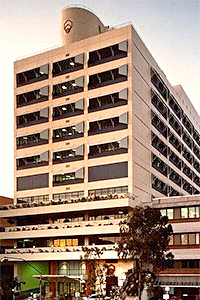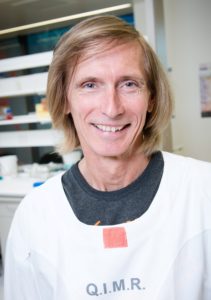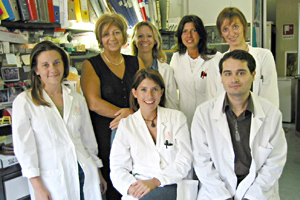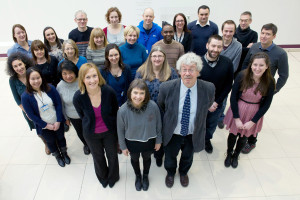
QIMR Berghofer Medical Research Institute
300 Herston Rd
Herston
QLD 4029
Australia
Ph: 61-7-33620306
Fax: 61-7-38453508
Group Leader
Nicholas Hayward PhD

E-mail: nick.hayward@qimr.edu.au
Web: http://www.qimrberghofer.edu.au/lab/oncogenomics/
Group Members
Dr Antonia Pritchard – Post-doctoral fellow
Dr Peter Johansson – Post-doctoral fellow
Ken Dutton-Regester – Post-doctoral fellow
Jane Palmer – Research nurse
Judith Symmons – Research nurse
Madeleine Howlie – Research nurse
Vaishnavi Nathan – Research technician
Research
Melanoma research in the Oncogenomics Laboratory is centred on three closely related themes:
- The identification of high penetrance germline mutations conferring susceptibility in families with multiple cases of melanoma.
To address this aim we have recruited >500 multiple-case melanoma families and have been systematically sequencing the exomes or genomes of affected family members to identify DNA variants that segregate with melanoma in each family and hence which may play a role in predisposing carriers to melanoma.
- The identification of low penetrance polymorphisms associated with increased risk of melanoma in the general population.
To address this aim we have recruited >1200 ‘sporadic’ melanoma cases (i.e. unselected for family history of melanoma) and have used genome-wide association studies (GWAS) to identify common DNA variants associated with melanoma susceptibility.
- The characterization of somatic mutations and dysregulated gene expression patterns responsible for melanoma development.
To address this aim we have been conducting whole-genome sequencing of >500 melanomas of diverse histological subtypes and combining these data with analysis of gene expression (RNASeq and microarray) to identify mutations and altered gene regulation responsible for driving melanocytic neoplasia.
Publications
Law MH, Montgomery GW, Brown KM, Martin NG, Mann GJ, HAYWARD NK, Macgregor S. Meta-Analysis Combining New and Existing Data Sets Confirms that the TERT-CLPTM1L Locus Influences Melanoma Risk. J Invest Dermatol. 2012 Feb;132(2):485-7
Yang XR, Brown K, Landi MT, Ghiorzo P, Badenas C, Xu M, HAYWARD NK, Calista D, Landi G, Bruno W, Bianchi-Scarrà G, Aguilera P, Puig S, Goldstein AM, Tucker MA. Duplication of CXC chemokine genes on chromosome 4q13 in a melanoma-prone family. Pigment Cell Melanoma Res. 2012 Mar;25(2):243-247.
Dutton-Regester K, Irwin D, Hunt P, Aoude LG, Tembe V, Pupo GM, Lanagan C, Carter CD, O’Connor L, O’Rourke M, Scolyer RA, Mann GJ, Schmidt CW, Herington A, HAYWARD NK. A high-throughput panel for identifying clinically relevant mutation profiles in melanoma. Mol Cancer Ther. 2012 Apr;11(4):888-97.
Dutton-Regester K, Aoude LG, Nancarrow DJ, Stark MS, O’Connor L, Lanagan C, Pupo GM, Tembe V, Carter CD, O’Rourke M, Scolyer RA, Mann GJ, Schmidt CW, Herington A, HAYWARD NK. Identification of TFG (TRK-fused gene) as a putative metastatic melanoma tumor suppressor gene. Genes Chromosomes Cancer. 2012 May;51(5):452-61.
Krauthammer M, Kong Y, Ha BH, Evans P, Bacchiocchi A, McCusker JP, Cheng E, Davis MJ, Goh G, Choi M, Ariyan S, Narayan D, Dutton-Regester K, Capatana A, Holman EC, Bosenberg M, Sznol M, Kluger HM, Brash DE, Stern DF, Materin MA, Lo RS, Mane S, Ma S, Kidd KK, HAYWARD NK, Lifton RP, Schlessinger, Boggon TJ, Halaban R. Exome sequencing identifies recurrent somatic RAC1 mutations in melanoma. Nature Genetics 2012 Sep;44(9):1006-14.
Kasparian NA, Bränström R, Chang YM, Affleck P, Aspinwall LG, Tibben A, Azizi E, Baron-Epel O, Battistuzzi L, Bruno W, Chan M, Cuellar F, Debniak T, Pjanova D, Ertmanski S, Figl A, Gonzalez M, HAYWARD NK, Hocevar M, Kanetsky PA, Leachman S, Bergman W, Heisele O, Palmer J, Peric B, Puig S, Schadendorf D, Gruis NA, Newton-Bishop J, Brandberg Y; for the Melanoma Genetics Consortium (GenoMEL). Skin Examination Behavior: The Role of Melanoma History, Skin Type, Psychosocial Factors, and Region of Residence in Determining Clinical and Self-conducted Skin Examination. Arch Dermatol. 2012 Oct;148(10):1142-51.
Wadt K, Choi J, Chung JY, Kiilgaard J, Heegaard S, Drzewiecki KT, Trent JM, Hewitt SM, HAYWARD NK, Gerdes AM, Brown KM. A cryptic BAP1 splice mutation in a family with uveal and cutaneous melanoma, and paraganglioma. Pigment Cell Melanoma Res. 2012 Nov;25(6):815-8.
Aoude LG, Vajdic CM, Kricker A, Armstrong B, HAYWARD NK. Prevalence of germline BAP1 mutation in a population-based sample of uveal melanoma cases. Pigment Cell Melanoma Res. 2013 Mar;26(2):278-9.
Iles MM, Law MH, Stacey SN, Han J, Fang S, Pfeiffer R, Harland M, Macgregor S, Taylor JC, Aben KK, Akslen LA, Avril MF, Azizi E, Bakker B, Benediktsdottir KR, Bergman W, Scarrà GB, Brown KM, Calista D, Chaudru V, Fargnoli MC, Cust AE, Demenais F, de Waal AC, Dębniak T, Elder DE, Friedman E, Galan P, Ghiorzo P, Gillanders EM, Goldstein AM, Gruis NA, Hansson J, Helsing P, Hočevar M, Höiom V, Hopper JL, Ingvar C, Janssen M, Jenkins MA, Kanetsky PA, Kiemeney LA, Lang J, Lathrop GM, Leachman S, Lee JE, Lubiński J, Mackie RM, Mann GJ, Martin NG, Mayordomo JI, Molven A, Mulder S, Nagore E, Novaković S, Okamoto I, Olafsson JH, Olsson H, Pehamberger H, Peris K, Grasa MP, Planelles D, Puig S, Puig-Butille JA; Q-MEGA and AMFS Investigators, Randerson-Moor J, Requena C, Rivoltini L, Rodolfo M, Santinami M, Sigurgeirsson B, Snowden H, Song F, Sulem P, Thorisdottir K, Tuominen R, Van Belle P, van der Stoep N, van Rossum MM, Wei Q, Wendt J, Zelenika D, Zhang M, Landi MT, Thorleifsson G, Bishop DT, Amos CI, HAYWARD NK, Stefansson K, Bishop JA, Barrett JH, the GenoMEL Consortium. A variant in FTO shows association with melanoma risk not due to BMI. Nature Genetics. 2013 Apr;45(4):428-32.
Puntervoll HE, Yang XR, Vetti HH, Bachmann IM, Avril MF, Benfodda M, Catricalà C, Dalle S, Duval-Modeste AB, Ghiorzo P, Grammatico P, Harland M, HAYWARD NK, Hu HH, Jouary T, Martin-Denavit T, Ozola A, Palmer JM, Pastorino L, Pjanova D, Soufir N, Steine SJ, Stratigos AJ, Thomas L, Tinat J, Tsao H, Veinalde R, Tucker MA, Bressac-de Paillerets B, Newton-Bishop JA, Goldstein AM, Akslen LA, Molven A. Melanoma prone families with CDK4 germline mutation: phenotypic profile and associations with MC1R variants. J Med Genet. 2013 Apr;50(4):264-70.
Liu H, Wang LE, Liu Z, Chen WV, Amos CI, Lee JE, Amfs Investigators QM, Investigators G, Iles MM, Law MH, Barrett JH, Montgomery GW, Taylor JC, Macgregor S, Newton Bishop JA, HAYWARD NK, Bishop DT, Mann GJ, Affleck P, Wei Q. Association between functional polymorphisms in genes involved in the MAPK signaling pathways and cutaneous melanoma risk. Carcinogenesis. 2013 Apr;34(4):885-92.
Hacker E, Nagore E, Cerroni L, Woods SL, HAYWARD NK, Chapman B, Montgomery GW, Soyer HP, Whiteman DC. NRAS and BRAF Mutations in Cutaneous Melanoma and the Association with MC1R Genotype: Findings from Spanish and Austrian Populations. J Invest Dermatol. 2013 Apr;133(4):1027-33.
Qian J, Liu H, Wei S, Liu Z, Li Y, Wang LE, Chen WV, Amos CI, Lee JE; GenoMEL investigators, Iles MM, Law MH; Q-MEGA and AMFS investigators, Barrett JH, Montgomery GW, Taylor J, Bishop JA, Macgregor S, Bishop DT, Mann GJ, HAYWARD NK, Wei Q. Association between putative functional variants in the PSMB9 gene and risk of melanoma – re-analysis of published melanoma genome-wide association studies. Pigment Cell Melanoma Res. 2013 May;26(3):392-401.
Nagore E, Hacker E, Martorell-Calatayud A, Traves V, Guillen C, HAYWARD NK, Whiteman D. Prevalence of BRAF and NRAS mutations in fast growing melanomas. Pigment Cell Melanoma Res. 2013 May;26(3):429-31.
Cao J, Wan L, Hacker E, Dai X, Lenna S, Jimenez-Cervantes C, Wang Y, Leslie N, Xu G, Goding C, Wildund H, Ryo B, Alani R, Dutton-Regester K, HAYWARD N, Wei W, Cui R. 2013. MC1R is a potent regulator of PTEN after UV exposure in melanocytes. Molecular Cell. 2013 Aug 22;51(4):409-22.
Gartner J, Parker S, Prickett T, Dutton-Regester K, Stitzel M, Lin J, Davis S, Simhadri V, Jha S, Katagiri N, Gotea V, Teer J, Wei X, Morken M, Bhanot U, NISC Sequencing Program, Chen G, Elnitski L, Davies M, Gershenwald J, Carter H, Karchin R, Robinson W, Robinson S, Rosenberg S, Collins F, Parmigianni G, Komar A, Kimchi-Safarty C, HAYWARD N, Margulies E, Samuels Y. 2013. Whole genome sequencing identifies a recurrent functional synonymous mutation in melanoma. Proc. Natl Acad Sci. U S A. 2013 Aug 13;110(33):13481-6.
Aoude LG, Wadt K, Bojesen A, Crüger D, Borg A, Trent JM, Brown KM, Gerdes AM, Jönsson G, HAYWARD NK. A BAP1 Mutation in a Danish Family Predisposes to Uveal Melanoma and Other Cancers. PLoS One. 2013 Aug 19;8(8):e72144.
Cronin JC, Watkins-Chow DE, Incao AA, Hasskamp JH, Schönewolf N, Aoude L, HAYWARD NK, Bastian BC, Dummer R, Loftus SK, Pavan W. SOX10 ablation arrests the cell cycle, induces senescence and suppresses melanomagenesis. Cancer Res. 2013 Sep 15;73(18):5709-18.
Dutton-Regester K, Kakavand H, Aoude L, Stark M, Gartside M, Johansson P, O’Connor L, Lanagan C, Pupo GM, Tembe V, Haydu L, Thompson J, Schmidt C, Scolyer R, HAYWARD NK. 2013. Melanomas of unknown primary have a mutation profile consistent with cutaneous sun exposed melanoma. Pigment Cell Melanoma Res. 2013 Nov;26(6):852-60.
Hacker E, Boyce Z, Kimlin MG, Wockner L, Pollak T, Vaartjes SA, HAYWARD NK, Whiteman DC. The effect of MC1R variants and sunscreen on the response of human melanocytes in vivo to ultraviolet radiation and implications for melanoma. Pigment Cell Melanoma Res. 2013 Nov;26(6):835-44.
Ohanna M, Cheli Y, Bonet C, Bonazzi VF, Allegra M, Giuliano S, Bille K, Bahadoran P, Giacchero D, Lacour JP, Boyle GM, HAYWARD NK, Bertolotto C, Ballotti R. Secretome from senescent melanoma engages the STAT3 pathway to favor reprogramming of naive melanoma towards a tumor-initiating cell phenotype. Oncotarget. 2013 Dec;4(12):2212-24.
Zebary A, Omholt K, van Doorn R, Ghiorzo P, Harbst K, Hertzman Johansson C, Höiom V, Jönsson G, Pjanova D, Puig S, Scarra GB, Harland M, Olsson H, Egyhazi Brage S, Palmer J, Kanter-Lewensohn L, Vassilaki I, HAYWARD NK, Newton-Bishop J, Gruis NA, Hansson J. Somatic BRAF and NRAS Mutations in Familial Melanomas with Known Germline CDKN2A Status: A GenoMEL Study. J Invest Dermatol. 2014 Jan;134(1):287-90.
Prickett TD, Gartner JJ, Parker S.C.J, Dutton-Regester K, Lin JC, Teer JK, Wei X, Jiang J, NISC Comparative Sequencing Program, Chen G, Davies MA, Gershenwald JE, Robinson W, Robinson S, Carter H, Karchin R, HAYWARD NK, Rosenberg SA, Margulies EH, Samuels Y. 2013. Somatic mutations in MAP3K5 attenuate its proapoptotic function in melanoma through increased binding to thioredoxin. J. Invest. Dermatol. 2014 Feb;134(2):452-60.
Nagore E, Requena C, Traves V, Guillen C, HAYWARD NK, Whiteman DC, Hacker E. Prognostic value of BRAF mutations in localized cutaneous melanoma. J Am Acad Dermatol. 2014 May;70(5):858-62.e1-2.
Robles-Espinoza CD, Harland M, Ramsay AJ, Aoude LG, Quesada V, Ding Z, Pooley KA, Pritchard AL, Tiffen JC, Petljak M, Palmer JM, Symmons J, Johansson P, Stark MS, Gartside MG, Snowden H, Montgomery GW, Martin NG, Liu JZ, Choi J, Makowski M, Brown KM, Dunning AM, Keane TM, López-Otín C, Gruis NA, HAYWARD NK, Bishop DT, Newton-Bishop JA, Adams DJ. POT1 loss-of-function variants predispose to familial melanoma. Nature Genetics 2014 May;46(5):478-81.
Marusiak AA, Edwards ZC, Hugo W, Trotter EW, Girotti MR, Stephenson NL, Kong X, Gartside MG, Fawdar S, Hudson A, Breitwieser W, HAYWARD NK, Marais R, Lo RS, Brognard J. Mixed lineage kinases activate MEK independently of RAF to mediate resistance to RAF inhibitors. Nature Communications. 2014 May 22;5:3901.
Dutton-Regester K, Gartner JJ, Emmanuel R, Qutob N, Davies MA, Gershenwald JE, Robinson W, Robinson S, Rosenberg SA, Scolyer RA, Mann GJ, Thompson JF, HAYWARD NK, Samuels Y. A highly recurrent RPS27 5’UTR mutation in melanoma. Oncotarget. 2014 May 30;5(10):2912-7.
Aoude LG, Xu M, Zhao ZZ, Kovacs M, Palmer JM, Johansson P, Symmons J, Trent JM, Martin NG, Montgomery GW, Brown KM, HAYWARD NK. Assessment of PALB2 as a Candidate Melanoma Susceptibility Gene. PLoS One. 2014 Jun 20;9(6):e100683.
Young RJ, Waldeck K, Martin C, Foo JH, Cameron DP, Kirby L, Do H, Mitchell C, Cullinane C, Liu W, Fox SB, Dutton-Regester K, HAYWARD NK, Jene N, Dobrovic A, Pearson RB, Christensen JG, Randolph S, McArthur GA, Sheppard KE. Loss of CDKN2A expression is a frequent event in primary invasive melanoma and correlates with sensitivity to the CDK4/6 inhibitor PD0332991 in melanoma cell lines. Pigment Cell Melanoma Res. 2014 Jul;27(4):590-600.
Song F, Amos CI, Lee JE, Lian CG, Fang S, Liu H, MacGregor S, Iles MM, Law MH, Lindeman NI, Montgomery GW, Duffy DL, Cust AE, Jenkins MA, Whiteman DC, Kefford RF, Giles GG, Armstrong BK, Aitken JF, Hopper JL, Brown KM, Martin NG, Mann GJ, Bishop DT, Bishop JA; the GenoMEL consortium, Kraft P, Qureshi AA, Kanetsky PA, HAYWARD NK, Hunter DJ, Wei Q, Han J. Identification of a melanoma susceptibility locus and somatic mutation in TET2. Carcinogenesis. 2014 Sep;35(9):2097-101.
Wadt KA, Aoude LG, Johansson P, Solinas A, Pritchard A, Crainic O, Andersen MT, Kiilgaard JF, Heegaard S, Sunde L, Federspiel B, Madore J, Thompson JF, McCarthy SW, Goodwin A, Tsao H, Jönsson G, Busam K, Gupta R, Trent JM, Gerdes AM, Brown KM, Scolyer RA, HAYWARD NK. A recurrent germline BAP1 mutation and extension of the BAP1 tumor predisposition spectrum to include basal cell carcinoma. Clin Genet. 2014 Sep 15. doi: 10.1111/cge.12501. [Epub ahead of print]
Iles MM, Bishop DT, Taylor JC, HAYWARD NK, Brossard M, Cust AE, Dunning AM, Lee JE, Moses EK, Akslen LA; AMFS Investigators, Andresen PA, Avril MF, Azizi E, Scarrà GB, Brown KM, Dębniak T, Elder DE, Friedman E, Ghiorzo P, Gillanders EM, Goldstein AM, Gruis NA, Hansson J, Harland M, Helsing P, Hočevar M, Höiom V; IBD investigators, Ingvar C, Kanetsky PA, Landi MT, Lang J, Lathrop GM, Lubiński J, Mackie RM, Martin NG, Molven A, Montgomery GW, Novaković S, Olsson H, Puig S, Puig-Butille JA; QMEGA and QTWIN Investigators, Radford-Smith GL, Randerson-Moor J; SDH Study Group, van der Stoep N, van Doorn R, Whiteman DC, MacGregor S, Pooley KA, Ward SV, Mann GJ, Amos CI, Pharoah PD, Demenais F, Law MH, Newton Bishop JA, Barrett JH; GenoMEL Consortium. The effect on melanoma risk of genes previously associated with telomere length. J Natl Cancer Inst. 2014 Sep 17;106(10). pii: dju267. doi: 10.1093/jnci/dju267. Print 2014 Oct.
Barbour AP, Tang YH, Armour N, Dutton-Regester K, Krause L, Loffler KA, Lambie D, Burmeister B, Thomas J, Smithers BM, HAYWARD NK. BRAF mutation status is an independent prognostic factor for resected stage IIIB and IIIC melanoma: Implications for melanoma staging and adjuvant therapy. Eur J Cancer. 2014 Oct;50(15):2668-76.
Lu Y, Ek WE, Whiteman D, Vaughan TL, Spurdle AB, Easton DF, Pharoah PD, Thompson DJ, Dunning AM, HAYWARD NK, Chenevix-Trench G; Q-MEGA and AMFS Investigators; ANECS-SEARCH; UKOPS-SEARCH; BEACON consortium, Macgregor S. Most common ‘sporadic’ cancers have a significant germline genetic component. Hum Mol Genet. 2014 Nov 15;23(22):6112-8.
Staaf J, Harbst K, Lauss M, Ringnér M, Måsbäck A, Howlin J, Jirström K, Harland M, Zebary A, Palmer JM, Ingvar C, Olsson H, Newton-Bishop J, Hansson J, HAYWARD N, Gruis N, Jönsson G; the Melanoma Genetics Consortium (GenoMEL). Primary Melanoma Tumors from CDKN2A Mutation Carriers Do Not Belong to a Distinct Molecular Subclass. J Invest Dermatol. 2014 Dec;134(12):3000-3.
Long GV, Fung C, Menzies AM, Pupo GM, Carlino MS, Hyman J, Shahheydari H, Tembe V, Thompson JF, Saw RP, Howle J, HAYWARD NK, Johansson P, Scolyer RA, Kefford RF, Rizos H. Increased MAPK reactivation in early resistance to dabrafenib/trametinib combination therapy of BRAF-mutant metastatic melanoma. Nature Communications. 2014 Dec 2;5:5694. doi: 10.1038/ncomms6694.
Aoude LG, Pritchard AL, Robles-Espinoza CD, Wadt K, Harland M, Choi J, Gartside M, Quesada V, Johansson P, Palmer JM, Ramsay AJ, Zhang X, Jones K, Symmons J, Holland EA, Schmid H, Bonazzi V, Woods S, Dutton-Regester K, Stark MS, Snowden H, van Doorn R, Montgomery GW, Martin NG, Keane TM, López-Otín C, Gerdes AM, Olsson H, Ingvar C, Borg A, Gruis NA, Trent JM, Jönsson G, Bishop DT, Mann GJ, Newton-Bishop JA, Brown KM, Adams DJ, HAYWARD NK. Nonsense Mutations in the Shelterin Complex Genes ACD and TERF2IP in Familial Melanoma. J Natl Cancer Inst. 2014 Dec 13;107(2). pii: dju408. doi: 10.1093/jnci/dju408. Print 2015 Feb.
Ranzani M, Alifrangis C, Perna D, Dutton-Regester K, Pritchard A, Wong K, Rashid M, Robles-Espinoza CD, HAYWARD NK, McDermott U, Garnett M, Adams DJ. BRAF/NRAS wild-type melanoma, NF1 status and sensitivity to trametinib. Pigment Cell Melanoma Res. 2015 Jan;28(1):117-9.
Barrett JH, Taylor JC, Bright C, Harland M, Dunning AM, Akslen LA, Andresen PA, Avril MF, Azizi E, Bianchi Scarrà G, Brossard M, Brown KM, Dębniak T, Elder DE, Friedman E, Ghiorzo P, Gillanders EM, Gruis NA, Hansson J, Helsing P, Hočevar M, Höiom V, Ingvar C, Landi MT, Lang J, Lathrop GM, Lubiński J, Mackie RM, Molven A, Novaković S, Olsson H, Puig S, Puig-Butille JA, van der Stoep N, van Doorn R, van Workum W, Goldstein AM, Kanetsky PA, Pharoah PD, Demenais F, HAYWARD NK, Newton Bishop JA, Bishop DT, Iles MM; on behalf of the GenoMEL Consortium. Fine mapping of genetic susceptibility loci for melanoma reveals a mixture of single variant and multiple variant regions. Int J Cancer. 2015 Mar 15;136(6):1351-60.
Sargen MR, Kanetsky PA, Newton-Bishop J, HAYWARD NK, Mann GJ, Gruis NA, Tucker MA, Goldstein AM, Bianchi-Scarra G, Puig S, Elder DE. Histologic features of melanoma associated with CDKN2A genotype. J Am Acad Dermatol. 2015 Mar;72(3):496-507.
Wadt KA, Aoude LG, Krogh L, Sunde L, Bojesen A, Grønskov K, Wartacz N, Ek J, Tolstrup-Andersen M, Klarskov-Andersen M, Borg Å, Heegaard S, Kiilgaard JF, Hansen TV, Klein K, Jönsson G, Drzewiecki KT, Dunø M, HAYWARD NK, Gerdes AM. Molecular characterization of melanoma cases in Denmark suspected of genetic predisposition. PLoS One. 2015 Mar 24;10(3):e0122662.
Aoude LG, Gartside M, Johansson P, Palmer JM, Symmons J, Martin NG, Montgomery GW, Hayward NK. Prevalence of Germline BAP1, CDKN2A, and CDK4 Mutations in an Australian Population-Based Sample of Cutaneous Melanoma Cases. Twin Res Hum Genet. 2015 Apr;18(2):126-33.
Law MH, Rowe C, Montgomery GW, HAYWARD NK, MacGregor S, Khosrotehrani K. PARP1 polymorphisms play opposing roles in melanoma occurrence and survival. Int J Cancer. 2015 May 15;136(10):2488-9.
Tembe V, Schramm SJ, Stark MS, Patrick E, Jayaswal V, Tang YH, Barbour A, HAYWARD NK, Thompson JF, Scolyer RA, Yang YH, Mann GJ. microRNA and mRNA expression profiling in metastatic melanoma reveal associations with BRAF mutation and patient prognosis. Pigment Cell Melanoma Res. 2015 May;28(3):254-66.
Pritchard AL, Hastie ML, Neller M, Gorman JJ, Schmidt CW, HAYWARD NK. Exploration of peptides bound to MHC class I molecules in melanoma. Pigment Cell Melanoma Res. 2015 May;28(3):281-94.
Stark MS, Klein K, Weide B, Haydu LE, Pflugfelder A, Tang YH, Palmer JM, Whiteman DC, Scolyer RA, Mann GJ, Thompson JF, Long GV, Barbour AP, Soyer HP, Garbe C, Herington A, Pollock PM, HAYWARD NK. The Prognostic and Predictive Value of Melanoma-related MicroRNAs Using Tissue and Serum: A MicroRNA Expression Analysis. EBioMedicine. 2015 May 12;2(7):671-80.
Kim H, Frederick DT, Levesque MP, Cooper ZA, Feng Y, Krepler C, Brill L, Samuels Y, HAYWARD NK, Perlina A, Piris A, Zhang T, Halaban R, Herlyn MM, Brown KM, Wargo JA, Dummer R, Flaherty KT, Ronai ZA. Downregulation of the Ubiquitin Ligase RNF125 Underlies Resistance of Melanoma Cells to BRAF Inhibitors via JAK1 Deregulation. Cell Reports. 2015 Jun 9;11(9):1458-73.
Wadt KA, Aoude LG, Golmard L, Hansen TV, Sastre-Garau X, HAYWARD NK, Gerdes AM. Germline RAD51B truncating mutation in a family with cutaneous melanoma. Fam Cancer. 2015 Jun;14(2):337-40.
Cancer Genome Atlas Network. Genomic Classification of Cutaneous Melanoma. Cell. 2015 Jun 18;161(7):1681-96.
Stark MS, Bonazzi VF, Boyle GM, Palmer JM, Symmons J, Lanagan CM, Schmidt CW, Herington AC, Ballotti R, Pollock PM, HAYWARD NK. miR-514a regulates the tumour suppressor NF1 and modulates BRAFi sensitivity in melanoma. Oncotarget. 2015 Jul 10;6(19):17753-63.
Tiffen JC, Gunatilake D, Gallagher SJ, Gowrishankar K, Heinemann A, Cullinane C, Dutton-Regester K, Pupo GM, Strbenac D, Yang JY, Madore J, Mann GJ, HAYWARD NK, McArthur GA, Filipp FV, Hersey P. Targeting activating mutations of EZH2 leads to potent cell growth inhibition in human melanoma by derepression of tumor suppressor genes. Oncotarget. 2015 Sep 29;6(29):27023-36.
Pritchard AL, Burel JG, Neller MA, HAYWARD NK, Lopez JA, Fatho M, Lennerz V, Wölfel T, Schmidt CW. Exome sequencing to predict neoantigens in melanoma. Cancer Immunol Res. 2015 Sep;3(9):992-8.
Law MH, Bishop DT, Lee JE, Brossard M, Martin NG, Moses EK, Song F, Barrett JH, Kumar R, Easton DF, Pharoah PD, Swerdlow AJ, Kypreou KP, Taylor JC, Harland M, Randerson-Moor J, Akslen LA, Andresen PA, Avril MF, Azizi E, Scarrà GB, Brown KM, Dȩbniak T, Duffy DL, Elder DE, Fang S, Friedman E, Galan P, Ghiorzo P, Gillanders EM, Goldstein AM, Gruis NA, Hansson J, Helsing P, Hočevar M, Höiom V, Ingvar C, Kanetsky PA, Chen WV; GenoMEL Consortium; Essen-Heidelberg Investigators; SDH Study Group; Q-MEGA and QTWIN Investigators; AMFS Investigators; ATHENS Melanoma Study Group, Landi MT, Lang J, Lathrop GM, Lubiński J, Mackie RM, Mann GJ, Molven A, Montgomery GW, Novaković S, Olsson H, Puig S, Puig-Butille JA, Qureshi AA, Radford-Smith GL, van der Stoep N, van Doorn R, Whiteman DC, Craig JE, Schadendorf D, Simms LA, Burdon KP, Nyholt DR, Pooley KA, Orr N, Stratigos AJ, Cust AE, Ward SV, HAYWARD NK, Han J, Schulze HJ, Dunning AM, Bishop JA, Demenais F, Amos CI, MacGregor S, Iles MM. Genome-wide meta-analysis identifies five new susceptibility loci for cutaneous malignant melanoma. Nature Genet. 2015 Sep;47(9):987-95.
Rowe CJ, Law MH, Palmer JM, MacGregor S, HAYWARD NK, Khosrotehrani K. Survival outcomes in patients with multiple primary melanomas. J Eur Acad Dermatol Venereol. 2015 Nov;29(11):2120-7.
Aoude LG, Heitzer E, Johansson P, Gartside M, Wadt K, Pritchard AL, Palmer JM, Symmons J, Gerdes AM, Montgomery GW, Martin NG, Tomlinson I, Kearsey S, HAYWARD NK. POLE mutations in families predisposed to cutaneous melanoma. Fam Cancer. 2015 Dec;14(4):621-8.
Wilmott JS, Field MA, Johansson PA, Kakavand H, Shang P, De Paoli-Iseppi R, Vilain RE, Pupo GM, Tembe V, Jakrot V, Shang CA, Cebon J, Shackleton M, Fitzgerald A, Thompson JF, HAYWARD NK, Mann GJ, Scolyer RA. Tumour procurement, DNA extraction, coverage analysis and optimisation of mutation-detection algorithms for human melanoma genomes. Pathology. 2015 Dec;47(7):683-93.
Arafeh R, Qutob N, Emmanuel R, Keren-Paz A, Madore J, Elkahloun A, Wilmott JS, Gartner JJ, Di Pizio A, Winograd-Katz S, Sindiri S, Rotkopf R, Dutton-Regester K, Johansson P, Pritchard AL, Waddell N, Hill VK, Lin JC, Hevroni Y, Rosenberg SA, Khan J, Ben-Dor S, Niv MY, Ulitsky I, Mann GJ, Scolyer RA, HAYWARD NK, Samuels Y. Recurrent inactivating RASA2 mutations in melanoma. Nature Genet. 2015 Dec;47(12):1408-10.
Harland M, Petljak M, Robles-Espinoza CD, Ding Z, Gruis NA, van Doorn R, Pooley KA, Dunning AM, Aoude LG, Wadt KA, Gerdes AM, Brown KM, HAYWARD NK, Newton-Bishop JA, Adams DJ, Bishop DT. Germline TERT promoter mutations are rare in familial melanoma. Fam Cancer. 2016 Jan;15(1):139-44.
Johansson P, Aoude LG, Wadt K, Glasson WJ, Warrier SK, Hewitt AW, Kiilgaard JF, Heegaard S, Isaacs T, Franchina M, Ingvar C, Vermeulen T, Whitehead KJ, Schmidt CW, Palmer JM, Symmons J, Gerdes AM, Jönsson G, HAYWARD NK. Deep sequencing of uveal melanoma identifies a recurrent mutation in PLCB4. Oncotarget. 2016 Jan 26;7(4):4624-31.
De Paoli-Iseppi R, Johansson PA, Menzies AM, Dias KR, Pupo GM, Kakavand H, Wilmott JS, Mann GJ, HAYWARD NK, Dinger ME, Long GV, Scolyer RA. Comparison of whole-exome sequencing of matched fresh and formalin fixed paraffin embedded melanoma tumours: implications for clinical decision making. Pathology. 2016 Apr;48(3):261-6.
Hacker E, Olsen CM, Kvaskoff M, Pandeya N, Yeo A, Green AC, Williamson RM, Triscott J, Wood D, Mortimore R, HAYWARD NK, Whiteman DC. Histologic and Phenotypic Factors and MC1R Status Associated with BRAF(V600E), BRAF(V600K), and NRAS Mutations in a Community-Based Sample of 414 Cutaneous Melanomas. J Invest Dermatol. 2016 Apr;136(4):829-37.
Read J, Symmons J, Palmer JM, Montgomery GW, Martin NG, HAYWARD NK. Increased incidence of bladder cancer, lymphoid leukaemia, and myeloma in a cohort of Queensland melanoma families. Fam Cancer. 2016 Apr 23. [Epub ahead of print]
Taylor NJ, Handorf EA, Mitra N, Avril MF, Azizi E, Bergman W, Bianchi-Scarrà G, Bishop DT, Bressac-de Paillerets B, Calista D, Cannon-Albright LA, Cuellar F, Cust AE, Demenais F, Elder DE, Friedman E, Gerdes AM, Ghiorzo P, Goldstein AM, Grazziotin TC, Hansson J, HAYWARD NK, Hocevar M, Höiom V, Holland EA, Ingvar C, Landi MT, Landman G, Larre-Borges A, Leachman SA, Mann GJ, Nagore E, Olsson H, Palmer J, Perić B, Pjanova D, Puig S, Schmid H, van der Stoep N, Tucker MA, Wadt KA, Whitaker L, Yang XR, Newton Bishop JA, Gruis NA, Kanetsky PA; GenoMEL Consortium. Phenotypic and Histopathological Tumor Characteristics According to CDKN2A Mutation Status among Affected Members of Melanoma Families. J Invest Dermatol. 2016 May;136(5):1066-9.
Claps G, Cheli Y, Zhang T, Scortegagna M, Lau E, Kim H, Qi J, Li JL, James B, Dzung A, Levesque MP, Dummer R, HAYWARD NK, Bosenberg M, Brown KM, Ronai ZA. A Transcriptionally Inactive ATF2 Variant Drives Melanomagenesis. Cell Rep. 2016 May 31;15(9):1884-92.
Stark MS, Tom LN, Boyle GM, Bonazzi VF, Soyer HP, Herington AC, Pollock PM, HAYWARD NK. The ‘Melanoma-enriched’ microRNA miR-4731-5p acts as a tumour suppressor. Oncotarget. 2016 Jun 16. doi: 10.18632/oncotarget.10109. [Epub ahead of print]
Rowe CJ, Tang F, Hughes MC, Rodero MP, Malt M, Lambie D, Barbour A, HAYWARD NK, Smithers BM, Green AC, Khosrotehrani K. Molecular markers to complement sentinel node status in predicting survival in patients with high-risk locally invasive melanoma. Int J Cancer. 2016 Aug 1;139(3):664-72.
INVITED REVIEWS
Dutton-Regester K, HAYWARD NK. Reviewing the somatic genetics of melanoma: from current to future analytical approaches. Pigment Cell Melanoma Res. 2012 Mar;25(2):144-54.
Bonazzi VF, Stark MS, HAYWARD NK. MicroRNA regulation of melanoma progression. Melanoma Res. 2012 Apr;22(2):101-13.
Law M, MacGregor S, HAYWARD NK. Melanoma genetics: recent findings take us beyond well travelled pathways. J Invest Dermatol. 2012 Jul;132(7):1763-74.
Dutton-Regester K, HAYWARD NK. Whole genome and exome sequencing of melanoma: a step toward personalized targeted therapy. Adv Pharmacol. 2012;65:399-435.
Pritchard AL, HAYWARD NK. Molecular Pathways: MAP kinase pathway mutations and drug resistance. Clin Cancer Res. 2013 May 1;19(9):2301-9.
Robles-Espinoza CD, Del Castillo Velasco-Herrera M, HAYWARD NK, Adams DJ. Telomere-regulating Genes and the Telomere Interactome in Familial Cancers. Mol Cancer Res. 2015 Feb;13(2):211-22.
Aoude LG, Wadt KA, Pritchard AL, HAYWARD NK. Genetics of Familial Melanoma: 20 years after CDKN2A. Pigment Cell Melanoma Res. 2015 Mar;28(2):148-60.
Read J, Wadt KA, HAYWARD NK. Melanoma genetics. J Med Genet. 2016 Jan;53(1):1-14.
Zhang T, Dutton-Regester K, Brown KM, HAYWARD NK. The genomic landscape of cutaneous melanoma. Pigment Cell Melanoma Res. 2016 May;29(3):266-83.





